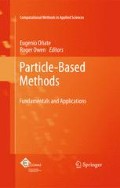Abstract
The contribution gives an overview on a discrete element model with polygonal particles in a two-dimensional setting allowing the simulation of granular as well as quasi-brittle material response. It briefly describes the basic formulation for geometry and applied contact models in normal and tangential direction, supplemented by friction on a background plate. Special emphasis is put on modeling of cohesion; three different models with an increasing complexity are introduced, namely an overlay brittle beam lattice, a beam with damage and an interface model. Homogenization of the discrete particle response is utilized deriving variables like stresses and strains for an interpretation in the context of classical and micropolar continua. Several numerical examples for different loading scenarios are added, among them the simulation of a quasi-brittle material sample with a heterogeneousmicrostructure. In addition conceptual small scale experimentswith regular particles of steel nuts have been performed; results from tests and simulations for samples with and without cohesion are compared.
Access this chapter
Tax calculation will be finalised at checkout
Purchases are for personal use only
Preview
Unable to display preview. Download preview PDF.
References
Allen, M.P., Tildesley, D.J., Computer Simulation of Liquids. Oxford University Press, Oxford, 1987.
Bićanić, N., Discrete element methods. In: Encyclopedia of Computational Mechanics: Volume 1: Fundamentals, Stein, E., de Borst, R., Hughes, T.J.R. (eds.), pp. 311–337. Wiley, Chichester, 2004.
Bićanić, N., Discrete element methods. In: The Finite Element Method for Solid and Structural Mechanics, 6th edn., Zienkiewicz, O.C., Taylor, R.L., pp. 245–277. Elsevier, Oxford, 2005.
Cundall, P.A., A discontinuous future for numerical modelling in geomechanics. Geotech. Eng. 149:41–47, 2001.
Cundall, P.A., Hart, R.D., Numerical modelling of discontinua. Eng. Comput. 9:101–113, 1992.
Cundall, P.A., Strack, O.D.L., A discrete numerical model for granular assemblies. Géotechnique 29:47–65, 1979.
D’Addetta, G.A., Discrete models for cohesive frictional materials. Ph.D. Thesis, Bericht Nr. 42, Institut für Baustatik, Universität Stuttgart, Germany, http://elib.unistuttgart.de/opus/volltexte/2004/1943/pdf/diss_gad.pdf, 2004.
D’Addetta, G.A., Ramm, E., A microstructure-based simulation environment on the basis of an interface enhanced particle model. Granul. Matter 8:159–174, 2006.
D’Addetta, G.A., Kun, F., Herrmann, H.J., Ramm, E., From solids to granulates – Discrete element simulations of fracture and fragmentation processes in geomaterials. In: Continuous and Discontinuous Modelling of Cohesive Frictional Materials, Vermeer, P.A., Diebels, S., Ehlers, W., Herrmann, H.J., Luding, S., Ramm, E. (eds.), Lecture Notes in Physics, vol. 586, pp. 231–258. Springer, Berlin, 2001.
D’Addetta, G.A., Kun, F., Ramm, E., On the application of a discrete model to the fracture process of cohesive granular materials. Granul. Matter 4:77–90, 2002.
D’Addetta, G.A., Schneider, B., Ramm, E., Particle models for cohesive frictional materials. In: Computational Modelling of Concrete Structures, Proceedings of EURO-C 2006, Meschke, G., de Borst, R., Mang, H., Bićanić, N. (eds.), Mayrhofen, Austria, 27–30 March 2006, pp. 269–280. Taylor & Francis, London, 2006.
Ehlers, W., Ramm, E., Diebels, S., D’Addetta, G.A., From particle ensembles to Cosserat continua: Homogenization of contact forces towards stresses and couple stresses. Int. J. Solids & Struct. 40:6681–6702, 2003.
Feng, Y.T., Owen, D.R.J., A 2D polygon/polygon contact model: Algorithmic aspects. Eng. Comput. 21:265–277, 2004.
Gear, C.W., Numerical Initial Value Problems in Ordinary Differential Equations. Prentice-Hall, Englewood Cliffs, 1971.
Hashin, Z., Analysis of composite materials – A survey. ASME J. Appl. Mech. 50:481–505, 1983.
Herrmann, H.J., Hansen, A., Roux, S., Fracture of disordered, elastic lattices in two dimensions. Phys. Rev. B 39:637–648, 1989.
Kun, F., Herrmann, H.J., A study of fragmentation processes using a discrete element method. Comput. Methods Appl. Mech. Eng. 138:3–18, 1996.
Kun, F., D’Addetta, G.A., Herrmann, H.J., Ramm, E., Two-dimensional dynamic simulation of fracture and fragmentation of solids. Comput. Assist. Mech. Eng. Sci. 6:385–402, 1999.
Moukarzel, C., Herrmann, H.J., A vectorizable random lattice. J. Stat. Phys. 68:911–923, 1992.
Pöschel, T., Schwager, T., Computational Granular Dynamics: Models and Algorithms. Springer, Berlin, 2005.
Tillemans, H.-J., Herrmann, H.J., Simulating granular solids under shear. Phys. A 217:261–288, 1995.
van Mier, J.G.M., Schlangen, E., Vervuurt, A., van Vliet, M.R.A., Damage analysis of brittle disordered materials: Concrete and rock. In: Mechanical Behaviour ofMaterials, Proceedings of the ICM7, Bakker, A. (ed.), pp. 101–126. Delft University Press, Delft, 1995.
Vonk, R., Influence of boundary conditions on softening of concrete loaded in compression. Report TUE/BKO 89.14, Faculteit Bouwkunde, Technische Universiteit Eindhoven, The Netherlands, 1989.
Vonk, R., Softening of concrete loaded in compression. Ph.D. Thesis, Technische Universiteit Eindhoven, The Netherlands, 1992.
Williams, J.R., O’Connor, R., Discrete element simulation and the contact problem. Arch. Comput. Methods Eng. 6:279–304, 1999.
Winkler, B.J., Traglastuntersuchungen von unbewehrten und bewehrten Betonstrukturen auf der Grundlage eines objektiven Werkstoffgesetzes für Beton. Ph.D. Thesis, Institut für Baustatik, Festigkeitslehre und Tragwerkslehre, Leopold-Franzens-Universität Innsbruck, Austria, 2001.
Author information
Authors and Affiliations
Corresponding author
Editor information
Editors and Affiliations
Rights and permissions
Copyright information
© 2011 Springer Science+Business Media B.V.
About this chapter
Cite this chapter
Schneider, B., D’Addetta, G.A., Ramm, E. (2011). On Material Modeling by Polygonal Discrete Elements. In: Oñate, E., Owen, R. (eds) Particle-Based Methods. Computational Methods in Applied Sciences, vol 25. Springer, Dordrecht. https://doi.org/10.1007/978-94-007-0735-1_6
Download citation
DOI: https://doi.org/10.1007/978-94-007-0735-1_6
Published:
Publisher Name: Springer, Dordrecht
Print ISBN: 978-94-007-0734-4
Online ISBN: 978-94-007-0735-1
eBook Packages: EngineeringEngineering (R0)

